“Our little colonial house”
Abby Aldrich Rockefeller and Bassett Hall
by Mary Miley Theobald
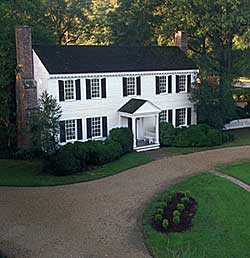
First light paints the old Bassett Hall farmstead with the tranquility the Rockefellers sought in a Williamsburg home. The house dates to 1753.
The 1901 marriage of the son of the richest man in America to the daughter of the most powerful man in the United States Senate had every outward appearance of a corporate merger. Acquaintances of the bride and groom knew better, although many of them—including the couple’s siblings—wondered how such different personalities would fare in the bonds of holy matrimony.
John D. Rockefeller Jr. was not the Gay Nineties model of a rich
man’s son. Raised in a strict Baptist household to shun
dancing, drinking, and parties, Rockefeller was a shy, cautious
young man. Frivolity and extravagance were alien. As he said,
he was the sort who got lost in a crowd, and he did not make friends
easily. Self-conscious about his name, he was at a loss when it
came to courting. While he was a Brown University undergraduate
in Providence, Rhode Island, he met Abby Greene Aldrich at the
first college dance he attended. Six years passed before he could
bring himself to propose, but it seemed as if they found in each
other’s personalities the reciprocals of their own.
After the engagement, Rockefeller wrote to his mother: “I
could bring you no daughter, mother, whom you could love and yearn
over and be more proud of than Abby. She will add new brightness
and honor to the name which I am so proud, so very proud, to give
her.”
Descended from a New England family whose ancestor had come over on the Mayflower, Abby Aldrich had inherited the clan’s famous charm from her politician father, Senator Nelson W. Aldrich. She lived in an imposing home at 110 Benevolent Street, among Providence’s toniest addresses. Impulsive, irreverent, and full of adventure, she was popular with the girls and surrounded by beaux. Brought up in Rhode Island and Washington, D.C., she benefited from a rigorous education in an era that relegated most girls to finishing school or less. Her father introduced her to art, literature, collecting, and politics. From an early age, she was at ease with people from all walks of life and all levels of society.
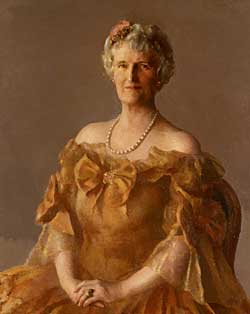
Robert Brackman painted Abby Rockefeller’s portrait in 1941. It hangs now in a Williamsburg museum.
Neither of the newlyweds cared for the Gilded Age ostentation that permeated the New York social scene. They valued privacy and disliked the press—not surprising considering the yellow journalism that savaged their fathers. They were careful with money and agreed that its value lay in its use for the greater good. When Rockefeller asked how his bride had spent the check he gave her for a wedding present, she said she had given it to the Young Women’s Christian Association to help pay for a new building. Too much money, Abby later wrote to one of her sons, “makes life too easy; people become self-indulgent and selfish and cruel.” Worried that the Rockefeller fortune would ruin their daughter and five boys, she and John gave out small allowances, preferring that the children earn money by doing chores.
They had in common a passion for the arts that grew over the years, even as it diverged. Both loved Chinese porcelain, oriental rugs, medieval art, and the old masters, but she also admired modernist painting and folk art. She became the force behind the creation of New York’s Museum of Modern Art; he spent his aesthetic energies founding the Cloisters, a museum dedicated to medieval masterpieces.
They did not agree on, among others, Vincent van Gogh, Edvard Munch, and Henri Matisse, whose works she had begun to collect. He thought them “terrible beyond words,” so she, who knew how to bend without breaking, hung them in a part of their New York house that he seldom visited.
In New York, the Rockefellers pursued their artistic interests along separate tracks. In Williamsburg, the tracks converged. Here the formal, traditional art of Great Britain and the American colonies peacefully coexisted with the American folk art she was discovering. Perhaps the strong colors and simplified renderings of folk paintings touched the same emotions that the bold brush strokes and distorted perspectives of contemporary art did. Her passion for this “art of the common man” made her one of its pioneer collectors in the late 1920s, the time her husband was beginning the restoration of Williamsburg.
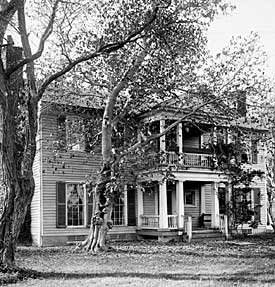
This circa 1907 photo
shows Bassett Hall
with a two-story front porch, since removed.
The flurry of memos that moved between Rockefeller headquarters in New York and restoration offices in Williamsburg, and the frequency of the couple’s visits, attest to their dedication to their Virginia project. Abby Rockefeller had her husband’s confidence and trust. She was involved with all of his projects, but especially with Williamsburg. In his correspondence with Williamsburg officials, Rockefeller refers to her repeatedly: “Mrs. Rockefeller and I did not feel . . . ,” or “Mrs. Rockefeller heartily concurs. . . .” He relied on her judgment.
Rockefeller’s interest in history and construction was most evident in the Restoration’s early years, when the city’s eighteenth-century buildings were being restored and rebuilt. Abby Rockefeller became more directly involved when the action moved indoors. A seasoned collector with a gift for interior design, she sought art and antiques to bring the colonial buildings back to colonial life. Frequently, she recruited her friends or her sister Lucy to keep an eye out for appropriate furnishings when they traveled. She said she would be glad for mirrors or water colors, portraits or tinsel pictures or paintings on velvet theorems or any little porcelain or pottery figures, or Lowestoft, or furniture if it was unusual. “I am quite intrigued with the idea of bringing back to Williamsburg the same sort of thing that was originally carried there by ships.”
Abby Rockefeller had been involved in the restoration and decorating of houses since she was sixteen, when her father bought a large old home in Providence for the Aldrich family. Her marriage into the Rockefeller family gave her several houses to furnish and renovate over the years, and she had almost single-handedly planned, designed, built, and furnished a YWCA hotel in Washington. She had an eye for design, and her taste was unpretentious. By the time the Colonial Williamsburg project came along in the late 1920s, she knew what was needed and how to accomplish it.
One thing she wanted was a Williamsburg home. It became obvious early on that the Restoration was going to be more ambitious than forecast and that she and her husband and children were going to be spending a good deal of time in the town. Besides, she adored Williamsburg.
The Reverend Dr. W. A. R. Goodwin, the rector of Bruton Parish Church and College of William and Mary fund-raiser who persuaded the Rockefellers to restore Williamsburg to its eighteenth-century aspect, was the first to suggest that the family needed a colonial house of its own. He advised Rockefeller to purchase Bassett Hall, a modest two-story frame house built around the middle of the 1700s, a place Goodwin had been thinking of for his family. “I wish you would buy Bassett Hall for yourself,” he told Rockefeller. “It would give you a charming vantage point from which to play with the vision and dream which you see.”
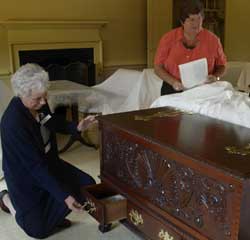
Colonial Williamsburg's Louise Kelly, left and Carolyn Weekley, right, pause during their superintendence of Basset Hall's revitalization to examine the chest Abby Rockefeller's brother made for her.
The house and three original outbuildings sat on 585 acres, most
of it woods. Unlike other homes in town, Bassett Hall was not
visible from the street. It was tucked away in a pocket of privacy
at the end of a tree-lined drive. But Rockefeller hesitated.
The house had been purchased from the elderly Smith sisters in
1927 in a deal that let them remain tenants for life, and Rockefeller
was not yet persuaded that he would need his own Williamsburg
residence. In 1930 the house caught fire. No one was injured,
but most of the roof and some of the second floor interiors were
damaged. The Smiths moved next door to Bassett Hall Cottage, and
soon thereafter traded their life tenancies for that smaller property
and other financial consideration.
Rockefeller said he had always “suspected that Mrs. Rockefeller, thanks to her very special gifts of persuasion, would eventually wear him down to the consistency of jelly” on matters she thought important. So it was that by 1931 he had come around to her way of thinking about a Williamsburg residence. “Oh, I am so happy today,” she told a Williamsburg hostess. “John has promised me we can have Bassett Hall. . . . And he says I can keep it if I promise not to take in tourists.”
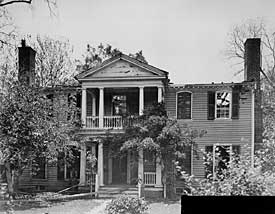
Fire destroyed Bassett
Hall’s roof and
damaged its interior May 16, 1930.
Modifications and repairs were finished in 1936. Despite the fire, much of the original interior woodwork, paneling, floors, and fireplace mantels was preserved. So as not to compromise the integrity of the eighteenth-century structure, a wing was added to the back. Here were the modern bathrooms, the kitchen, and the servants’ quarters, as well as an extra guest bedroom and dining room.
Abby Rockefeller decorated the house to be a home, not a museum. Some of the furnishings were family treasures brought to Williamsburg from other residences, like the hand-carved trunk her brother made for her as a wedding present and the pair of chairs that were the first antiques she bought. Other items were purchased for the house to create inviting, comfortable rooms where the family could relax. Turkish carpets shared the floor with needlework rugs she stitched herself, a Chinese dinner service graced the dining table, and other oriental porcelains decorated the mantels and tables. She spread more than 125 pieces of folk art, more than half of them paintings, throughout the rooms. She insisted on furniture that was comfortable and attractive. “If I have got to live with a thing,” she wrote, “I would like to have it good looking.”
In 1935 she loaned a portion of her folk art collection of paintings and sculpture to Colonial Williamsburg to be exhibited in the Ludwell-Paradise House on Duke of Gloucester Street. Four years later, she made the loan a gift, along with other pieces. She continued buying chalkware, Frakturs, theorems, portraits, paintings, glassware, needlework, quilts, and carvings for the family’s enjoyment and placed them throughout the rooms of Bassett Hall.
Though modern art appalled her husband, folk art appealed to him in its Williamsburg context. “Some people don’t care for this amateur art,” he told a reporter, “and don’t see any reason for having it. But it looks right in a setting like this, because these are the very pictures people would have hung on their walls at this period. In fact, I think that is one reason why Mrs. Rockefeller is so delighted with Bassett Hall. Now at least she has a chance to use her antiques and paintings in their proper setting.”
The Rockefellers treasured the “peaceful and homelike” qualities of their house. They tended to visit during spring and fall for about six weeks each time. These are Virginia’s most beautiful seasons, when gentle breezes refresh the warm air and the summertime humidity gives way to cloudless blue skies, and the Rockefellers took advantage of everything the outdoors had to offer. They enjoyed long walks along woodland paths, boating on the property’s small pond, and sitting beneath the canopy of an ancient oak, the Great Oak, or in the airy garden teahouse. She took a hand in the gardens and transformed one of the original outbuildings into a flower preparation space.
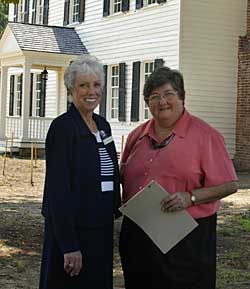
Kelley and Weekley intend to have Bassett Hall ready for reopening as a Colonial Revival exhibit in 2003.
Bassett Hall was Abby Rockefeller’s favorite house. It was nothing like the other Rockefeller residences: the Eyrie in Maine with sixty-five rooms or their nine-story New York house on 54th Street. While living in “our little colonial house,” she felt at home, surrounded by the array of objects she cherished. She said, “I really love that place.”
She was convinced that visiting Williamsburg was good for her health—she had a weak heart—and for her husband’s as well. “I have been delighted that during our stay here Papa has felt sufficiently rested and well for us to see something of our neighbors who are such nice people,” she wrote to one of her sons. Bassett Hall was a refuge from her busy New York life. Often, when she referred to the place in her letters, the words “peace and quiet” turn up. “I would like to stay on here for a month longer. It is so peaceful and quiet and the lack of excitement keeps my blood pressure from soaring to the skies.”
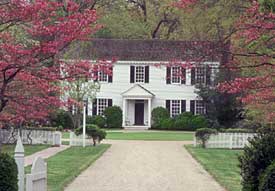
The Rockefellers found Bassett Hall particularly appealing in the spring when redbuds bloomed. Autumn was a favorite time, too.
The Rockefellers enjoyed wandering Williamsburg’s streets in the evenings. “I constantly feel myself carried back in my mind to the days of the American Revolution,” she wrote. “Particularly at night, when we walk along the streets, I feel as if I might hear swords clanking.” Together they strolled Duke of Gloucester Street to the small movie theater near the college end of town, sat through the film in the back row, and ambled home, or sat in front of the post office across the street watching passersby.
The Rockefeller family donated Bassett Hall to Colonial Williamsburg in 1979, and it opened to the public soon after as a museum, its furnishings and rooms presented much as they appeared when the Rockefellers lived there. In the winter of 2000, it was closed for major maintenance: replacing the roof and waterproofing the foundations were the most compelling projects. “Because the house had to be closed for a couple years, it was the perfect time to accomplish other things,” said Carolyn Weekley, the Juli Grainger Director of Museums and overseer of the work. “We are also repainting the exterior, replacing protective storm windows, repairing ceiling plaster, and bringing the buildings up to code so they are accessible to the handicapped visitor.” Colonial Williamsburg archaeologists took the opportunity to excavate around the foundations, where they found bits and pieces of eighteenth-century household items and learned more about the building’s complicated construction.
When Bassett Hall reopens in 2003, visitors will see more of the place. Louise Kelley, manager of Bassett Hall and Carter’s Grove, says, “Guests will view the four rooms and hall of the eighteenth-century house, walk through the dining room, pantry, kitchen, and one of the housekeeper’s rooms, and exit into the restored gardens. Outside, the original dairy and kitchen outbuildings will be open, and the 1930s teahouse.” A new exhibit will be offered in the Reception Building to teach visitors about the early years of the Restoration and the Rockefellers’ role.
“Bassett Hall, along with Carter’s Grove, tells the Colonial Revival story,” Weekley said. “The gardens behind Bassett Hall will allow us to tell the Colonial Revival landscape story.” The gardens changed after Abby’s death in 1948, and declined. Visitors will see the gardens as they appeared at their peak in the 1940s.
The money to restore Bassett Hall and its gardens came as a gift from Abby and George O’Neill of Oyster Bay, New York. Both have had a long association with Colonial Williamsburg, serving on the foundation’s board of trustees for years. Abby O’Neill is the granddaughter of John and Abby Rockefeller.
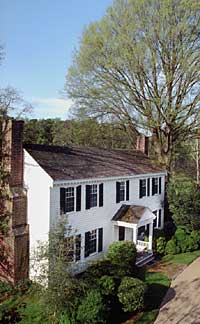
Bassett Hall looks much as the Rockefellers left it.
Bassett Hall may have been her grandmother’s favorite house, but it was never home. Nor was it the apartment on Park Avenue or the mansion in Maine or any of the residences Abby Aldrich Rockefeller and her husband shared during their forty-seven years of married life. “I am happy and contented wherever your father happens to be,” she wrote her youngest son. “He means home to me. I really feel sorry for the unhappy people who cannot find companionship in their married lives. I do not believe that it is something that happens, I think it is something that is achieved.”
Mary Miley Theobald wrote about the Colonial Revival in the summer 2002 journal. She says that much of the information in this article comes from Bernice Kert’s Abby Aldrich Rockefeller: The Woman in the Family (1993), which she recommends to people interested in reading more.
